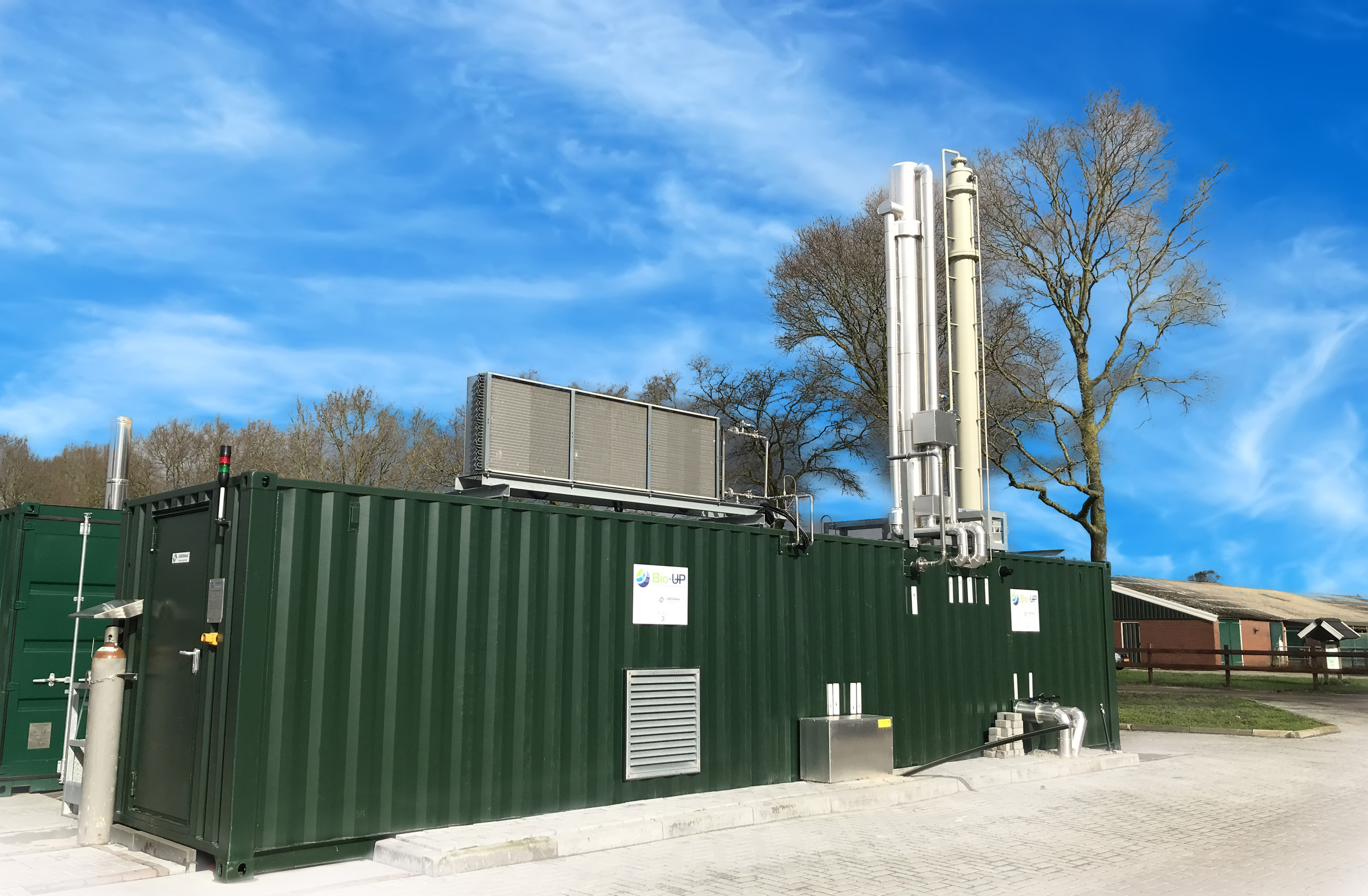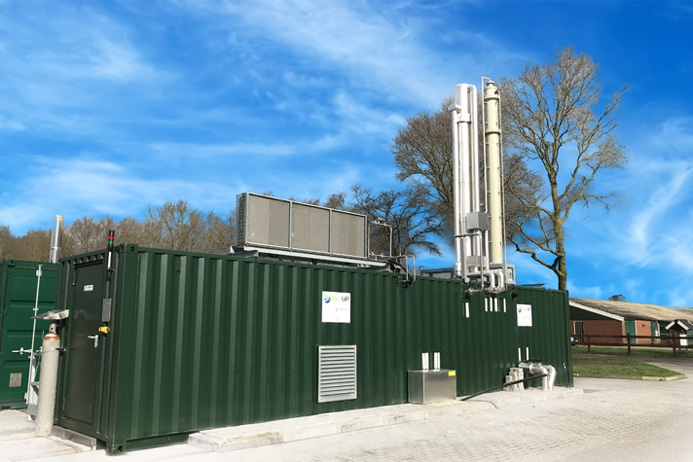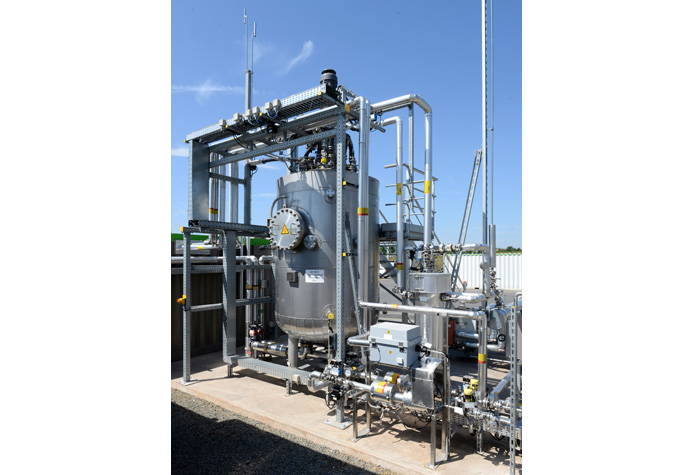Hydrothermal gasification

This was the challenge posed by the 2020 Innovation Factory. Three innovative European companies caught our attention. Presentation.
GRTgaz supports the emergence of the innovative hydrothermal gasification sector. This procedure converts wet and liquid biomass such as sludge from water treatment plants, livestock effluents, and digestates from biomethane production into high-pressure syngas. But how to purify this syngas for injection into the network, allowing the hydrothermal gasification sector to really take off? In 2020, Europe had no industrial or marketed system to achieve this critical step. The goal of the 2020 Open Innovation Factory Call to Projects was hence to identify innovative companies able to provide the missing piece of the puzzle. Our three winners.
Greenmac: the most mature solution
Greenmac is a young Dutch company created in 2015 under the umbrella of the Rootselaargroup. It specialises in providing tailor-made, turnkey biogas purification systems.
Why did you choose this company?
Robert Muhlke (GRTgaz Hydrothermal Gasification Project Director): Greenmac developed a solution that combines amine scrubbing with membrane technology, which is compatible with hydrothermal gasification both with and without catalysis. The company also knows how to recover the pressure and heat induced by this process. Excess pressure leaving the gasifier is transformed into electricity. Next, carbon dioxide is removed using the LP Cooab® innovative amine scrubbing technique. Finally, membrane technology is used to purify the hydrogen for reuse. From both technical and economic standpoints, Greenmac seemed to offer the strongest indicators of success.
What will this bring to GRTgaz?
Robert Muhlke: Greenmac's solutions are highly mature. Some of them will surely need to go through prototyping, but the company is ready to put together the equipment and move forward in developing an industrial tool. This will help us to industrialise the sector more quickly.
How did the company arrive at this solution?
Greenmac: Given our experience in biogas purification, GRTgaz approached us to take part in the Open Innovation challenge. Greenmac stands out though its highly specific expertise arising from a proficiency in various technologies for more than 30 years (VPSA, then amine scrubbing and membranes). We pay close attention to developments in hydrothermal gasification, and believe we can contribute to these by using mature techniques tailored to the specific demands of gasification. This allows projects to benefit from a greater depth of operational experience, increasing economic efficiency.

Arol Energy: Made-in-France Innovation
Arol Energy is a French start-up based in the Haute-Savoie region. It has developed an expertise in biogas treatment and recovery, in particular biomethane using innovative patented membrane separation technologies and amine scrubbing.
Why did you choose this company?
Robert Muhlke: Arol Energy is focused on hydrothermal gasification with catalysis using a solution based on membrane gas separation. This process can be entirely mechanical, reaching a basic purification yield of around 75%. By using one or more recirculation steps, the purification yield can even be as high as 99%. The fact that this is a French company was also important, as we want to support the emergence of a French hydrothermal gasification sector.
What will this bring to GRTgaz?
Robert Muhlke: Beyond the solution itself, Arol Energy can deliver turnkey biogas purification facilities, from design to construction, as well as the on-site commissioning of facilities including operator training, while providing maintenance and monitoring.
How did the company arrive at this solution?
Arol Energy: Our proposed technical solution came about thanks to our specific expertise in gas purification acquired over many years of development work. The close collaboration between Arol Energy and Air Products also allowed us to develop a solution that fully and effectively embraced the need for innovation. This will allow Arol Energy to position itself within the developing syngas market with highly relevant solutions and expertise.
With microbEnergy, bacteria hold all the aces
microbEnergy GmbH is a German company founded in 2012 and a subsidiary of the Viessmann group. It has developed an innovative biological methanation process with the given name BiON®.
Why did you choose this company?
Robert Muhlke: The biological methanation solution developed by microbEnergy based on gas flows from hydrothermal gasification without catalysis is extremely interesting. It relies on an almost-natural process in which specialist micro-organisms – bacteria – do all the work! This means that there are no negative secondary effects and the solution is extremely flexible, unlike methanation that uses catalysts.
What will this bring to GRTgaz?
Robert Muhlke: microbEnergy’s high-pressure adapted technology is an interesting diversification for syngas methanation that goes well beyond the planned instances of other low-pressure renewable gas production technologies (Power to Gas, pyrogasification, anaerobic digestion). It creates additional renewable gas from CO2 and hydrogen, whether this is naturally present in the gas mix or introduced artificially. So this is one more string to the bow of the up-and-coming hydrothermal gasification sector, which seems better suited to small facilities.
How did the company arrive at this solution?
microbEnergy: Since 2011, we have been working on an innovative technology to produce synthetic methane from hydrogen and CO2 using micro-organisms. The BiON® process for producing biomethane from raw gas such as biogas or treated gas is already operational on a mature, industrial scale and available on the market. In the course of this research, microbEnergy discovered that the biological process works extremely well at high pressure and reacts very robustly for a range of trace gases such as H2S, CO, NH3, etc. These features may also give rise to new, innovative applications for the purification of high-pressure synthetic gas. While these synthetic gas use cases are still in their early stages, they point to a bright future.
